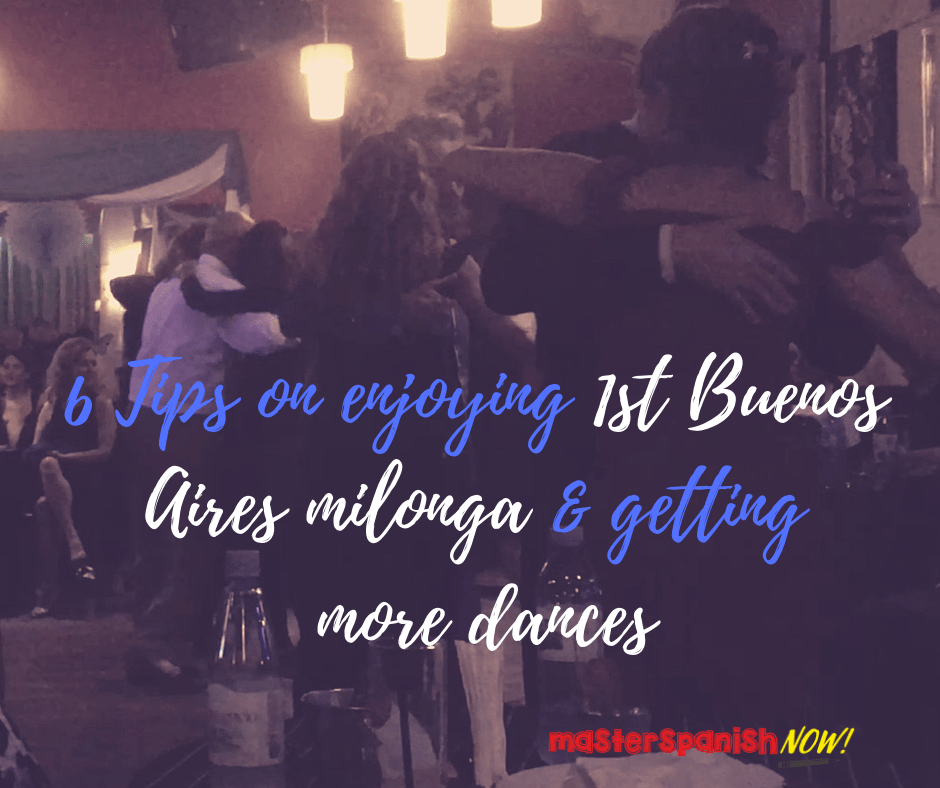I always remember my first Buenos Aires milonga at El Beso 4 years ago. I sat in the third row of the lady section like a wallflower for hours, watching my neighbors being invited over and over. I never succeed in catching the eyes of any gentleman. Every time after my neighbors were out on the dance floor, I felt very exposed with only empty seats surrounding me. I left disheartened. Walking on the busy Avenida Corrientes, I kept thinking what was wrong with me.
Fast forward to 2 months ago, I went to the same milonga and things changed. I was still sitting on the third row, but I became the few tangueras who always got onto the dance floor first every time a tanda (a set of tango music) start. I left the milonga early not because I didn’t get invited, but because my feet were sore and the floor’s got too crowded to move.
What has led to this transform? I have many hard-learned lessons over these years. I wish someone would have given me the following 6 tips earlier so I’d get a head start in milongas and saved many disappointed nights.
So here I’m sharing these tips for having fun and getting more dances in Buenos Aires milongas, which some of them also apply for milongas, festivals and marathons in other places where you are new and don’t know a soul.
1. Go early/make reservation
I can’t stress enough the importance of the location of your seat. It affects how much you are seen and the ease of cabeceo (the use of sight for dance invitation) with others, especially for ladies. (For men, in Buenos Aires milonga you are allowed to stand up and walk around the room to widen your search for partner ). So try to make a reservation before the milonga, or go early.
2. Attend the class before the milonga
In Buenos Aires there’s often a tango class which the fee is included in the ticket of the milonga. Taking part in the class before the milonga is a good way to make friends, so at the start of the milonga it will be a cinch to get dances. The class will also help you warm up and know the place better and reduce the anxiety of dancing at a venue for the first time.
3. Don’t take the first invitation
This may sound counter-intuitive, but what I am suggesting is not to take the invitation when you’ve just arrived the milonga and got an invitation from an unknown person. I often got the worse tanda of the night because I was rushing to the floor and didn’t observe the dance of my partner before taking the invitation. This might impact the invitation you get later on as milongueros would observe the dance of a new face before deciding to dance with him/her. If your first tanda is unappealing, and you are seen dancing in bad posture, you may end up getting fewer dances that night.
4. Interact with your neighbors
In Buenos Aires milongas you’d often need to share a table with other milongueros/as. Be friendly and say “Hola! Cómo estás?” (Hi, how are you?) or “Todo bien?” (Everything’s good?). Engage in small talks with them when they are not busy for cabeceo. Their friendliness and the advice offered to you would often surprise you. I have got many suggestions of the best milongas in town from my neighbors. They would be more likely to dance with you too- I have once danced with my neighbor who was a female leader, and that was the best tanda of the night.
5. Dress for success
In Buenos Aires milongas people would usually dress classy to milonga. Even in an afternoon milonga such as Nuevo Chique, you would see old ladies wearing their satin or velvet dress and hair arranged in elegant updos, and old gentlemen dressing neatly in their suits. Keep your jeans and T-shirt in wardrobe and match into the dance hall in your best attire! However, it may not be a good occasion to show off your newly bought Comme il faut, as people might see you as a nouveau and rich tango tourist. It’s best to wear shoes that have been worn for some time, as they are more comfortable for your feet and would show to the others you are a seasoned dancer.
6. Thanks the organizers before you leave
This is a point which many people may overlook. Organizing a milongas requires a lot of planning and coordination. By thanking the organizers you show your appreciation for their hard work. It’s also a good way to establish connection, so that when you return the next time, they may offer you a better seat.
Like our blog post and want to read more? Like our Facebook Page so you won’t miss our posts (plus you can find load of FREE resources for learning Spanish for tango!)
Want more Spanish practice? You can book a class with our Tango Spanish teachers who are tangueras living in Buenos Aires!
Going to Buenos Aires soon? Check out our books Tango Spanish and Buenos Aires Travel Tips and Tango Spanish: Essential Phrase Book For Tango Class (And Language Guide for Tango Shoe Shopping).



